

Distinct conformational states of SARS-CoV-2 spike protein. Abstract Intervention strategies are urgently needed to control the SARS-CoV-2 (severe acute respiratory syndrome coronavirus 2) pandemic.
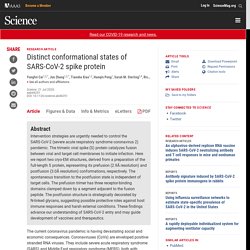
The trimeric viral spike (S) protein catalyzes fusion between viral and target cell membranes to initiate infection. Here we report two cryo-EM structures, derived from a preparation of the full-length S protein, representing its prefusion (2.9Å resolution) and postfusion (3.0Å resolution) conformations, respectively. The spontaneous transition to the postfusion state is independent of target cells. The prefusion trimer has three receptor-binding domains clamped down by a segment adjacent to the fusion peptide. The current coronavirus pandemic is having devastating social and economic consequences. For all enveloped viruses, membrane fusion is a key early step for entering host cells and establishing infection (10). SARS-CoV-2 T cell immunity: Specificity, function, durability, and role in protection.
Abstract.
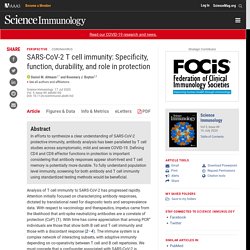
Blood vessel attack could trigger coronavirus’ fatal ‘second phase’ Science’s COVID-19 reporting is supported by the Pulitzer Center.
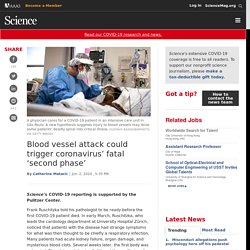
Frank Ruschitzka told his pathologist to be ready before the first COVID-19 patient died. In early March, Ruschitzka, who leads the cardiology department at University Hospital Zürich, noticed that patients with the disease had strange symptoms for what was then thought to be chiefly a respiratory infection. Many patients had acute kidney failure, organ damage, and mysterious blood clots. Several weeks later, the first body was autopsied: Tiny clots and dead cells littered the capillaries of the lungs, and inflammation had distended blood vessels supplying every organ in the body. Steroid dexamethasone may quickly be added to the global standard of care for severe COVID-19 patients. Science’s COVID-19 reporting is supported by the Pulitzer Center.

After months of dire news about the spread of the novel coronavirus and a mounting global death toll, a glimmer of hope arrived today: Researchers announced that dexamethasone, a cheap, widely available corticosteroid, significantly reduced deaths of severely sick COVID-19 patients in a major clinical trial. Although full trial data have not yet been released, several outside commentators hailed the result as a “breakthrough.” “These are really surprising, but really very convincing results,” says Martin Landray of the University of Oxford, one of the principal investigators of the Recovery trial in the United Kingdom that evaluated the steroid.
If they hold up, adds Devi Sridhar, an expert on global public health at the University of Edinburgh, they could be a game-changer for critical patients, as the drugs are accessible even in lower-income countries. Related. An orally bioavailable broad-spectrum antiviral inhibits SARS-CoV-2 in human airway epithelial cell cultures and multiple coronaviruses in mice.
Catastrophic consequences Broad-spectrum antivirals are desirable, particularly in the context of emerging zoonotic infections for which specific interventions do not yet exist.
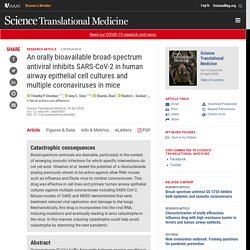
Sheahan et al. tested the potential of a ribonucleoside analog previously shown to be active against other RNA viruses such as influenza and Ebola virus to combat coronaviruses. Squalene-based multidrug nanoparticles for improved mitigation of uncontrolled inflammation in rodents. Uncontrolled inflammation is a key health challenge and is associated with numerous diseases (1–3).
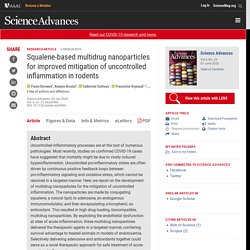
Recently, coronavirus disease 2019 (COVID-19) infections have been recognized as leading to a hyperinflammatory state characterized by a fulminant cytokine storm (hypercytokinemia) before acute respiratory distress syndrome and death (4). A growing understanding of the pathophysiology accompanying acute inflammation can help devise novel therapeutics for inflammatory diseases (5). Of particular relevance is that severe inflammation is associated with significant alterations to redox balance (6), inducing oxidative stress to tissues and cells. Evidence accumulated over the past two decades has pointed to significant connections between inflammation and oxidative stress, both processes contributing to fuel one another, thereby establishing a vicious cycle able to perpetuate and propagate the inflammatory response (7, 8). Abrupt decline in tropospheric nitrogen dioxide over China after the outbreak of COVID-19.
Abstract China’s policy interventions to reduce the spread of the coronavirus disease 2019 have environmental and economic impacts.

Tropospheric nitrogen dioxide indicates economic activities, as nitrogen dioxide is primarily emitted from fossil fuel consumption. Elusive consensus: Polarization in elite communication on the COVID-19 pandemic. Abstract Cues sent by political elites are known to influence public attitudes and behavior.
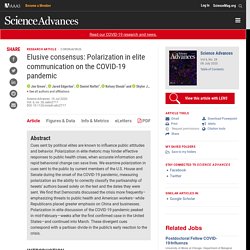
Polarization in elite rhetoric may hinder effective responses to public health crises, when accurate information and rapid behavioral change can save lives. We examine polarization in cues sent to the public by current members of the U.S. House and Senate during the onset of the COVID-19 pandemic, measuring polarization as the ability to correctly classify the partisanship of tweets’ authors based solely on the text and the dates they were sent. We find that Democrats discussed the crisis more frequently–emphasizing threats to public health and American workers–while Republicans placed greater emphasis on China and businesses.
In democratic countries, the public is highly responsive to cues sent by political elites (1, 2) whose messages can encourage unity or deepen social cleavages. ‘Ethically troubling.’ University reopening plans put professors, students on edge. Come August, hundreds of universities across the United States are poised to reopen their campuses with a mix of online and in-person courses.

Only a handful are aiming for an entirely online semester. But as the machinery of higher education cranks back into action, faculty, staff, and students are voicing concerns that, with COVID-19 cases surging in many parts of the country, employees are being forced to put their health—and the health of others—at unnecessary risk. At many universities, employees will not be permitted to teach or work from home unless—due to age or preexisting health conditions—they’re at risk of a severe outcome from COVID-19.